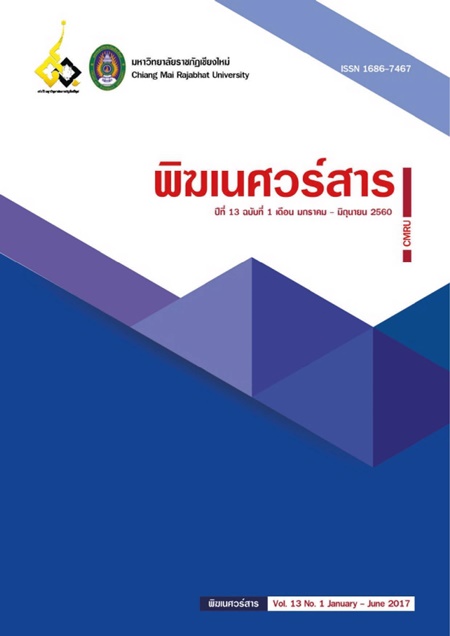ผลของการนวดต่อการลดภาวะปวดเมื่อยกล้ามเนื้อภายหลังจากการออกกำลังกายของกล้ามเนื้อเหยียดเข่าในชายสุขภาพดี
Main Article Content
บทคัดย่อ
การวิจัยครั้งนี้มีวัตถุประสงค์ เพื่อเปรียบเทียบผลการนวดต่อการลดภาวะปวดเมื่อยกล้ามเนื้อภายหลังจากการออกกำลังกายของกล้ามเนื้อเหยียดเข่าในชายสุขภาพดี โดยมีอาสาสมัครเพศชาย จำนวน 17 คน โดยสุ่มแบ่งเป็น กลุ่มควบคุม(ขาข้างที่ไม่ได้นวด) และกลุ่มทดลอง (ขาข้างที่ได้นวด) การทดลองที่ใช้ในการศึกษาครั้งนี้ได้แก่ การวัดระดับความเจ็บปวด (VAS) การวัดระดับขีดกั้นความเจ็บปวดจากการกด (PPT) ช่วงการเคลื่อนไหวแบบกระทำเอง (AROM) และแบบกระทำให้ (PROM) ความแข็งแรงของกล้ามเนื้อแบบหดตัวอยู่กับที่สูงสุด (PIT) และแบบเคลื่อนไหวสูงสุด (DPT) โดยทำการวัดผล 5 ครั้ง คือ ครั้งที่ 1 ก่อนออกกำลังกาย ครั้งที่ 2 หลังการออกกำลังกายทันที ครั้งที่ 3 ก่อนนวด ครั้งที่ 4 หลังนวด (48 ชั่วโมงหลังออกกำลังกาย) และครั้งที่ 5 วันที่ติดตามอาการ (96 ชั่วโมง ในหลังจากออกกำลังกายไปแล้ว) ซึ่งได้นำข้อมูลมาวิเคราะห์ โดยใช้สถิติ Mixed model of ANOVA Test ผลการวิจัย พบว่าในกลุ่มควบคุมภายหลังจากการออกกำลังกายมีค่า AROM และ PIT ลดลงอย่างมีนัยสำคัญทางสถิติ (P-value ≥ 0.05) และมีค่า PIT ลดลง มากขึ้นในวันที่ 2 จากอาการปวดเมื่อยกล้ามเนื้อภายหลังจากการออกกำลังกายในกลุ่มทดลองหลังจากได้รับการนวด ค่า VAS และ DPT ไม่มีความแตกต่างกันกับค่าเริ่มต้น ซึ่งหมายความว่าการนวดอาจช่วยลดอาการปวดเมื่อยของกล้ามเนื้อทำให้ลด VAS และส่งเสริม DPT ภายหลังจากการนวดได้
EFFECT OF MASSAGE ON RELIEVING DELAYED ONSET MUSCLE SORENESS OF THE KNEE EXTENSORS IN HEALTHY MALE
The purpose of this research was to study the effects of massage on relieving delayed onset muscle soreness of the knee extensors in healthy male. Participants were 17 male volunteers. The sampling’s leg sides were divided into 2 groups; one side that did not receive massage was counted as a control group and another side that received massage was an experiment group. The measurements used in this research consisted of Visual analogue scale (VAS), Pressure pain threshold (PPT), Active range of motion (AROM), Passive range of motion(PROM), Peak Isometric torque (PIT), and Dynamic peak torque of quadriceps (DPT). The experiment was performed on 5 time 1st time (pre-exercise), 2rd time (post-exercise), 3th time (before massage), 4th time (after getting massage)and 5th (followed up) at 96 hours after exercising. The statistic used to analyse the data included the Mixed Model of ANOVA. The results were that the control group, being observed after exercise, shown that the AROM and the PIT decreased significantly (P-Value ≥ 0.05) and The PIT declined statistically more in the second day. The VAS and the DPT of the experiment group were same as baseline. It could conclude that the massage could relieve the muscle pain and improve strength.
Article Details
บทความที่ได้รับการตีพิมพ์เป็นลิขสิทธิ์ของบัณฑิตวิทยาลัย มหาวิทยาลัยราชภัฎเชียงใหม่
ข้อความที่ปรากฏในบทความแต่ละเรื่องในวารสารวิชาการเล่มนี้เป็นความคิดเห็นส่วนตัวของผู้เขียนแต่ละท่านไม่เกี่ยวข้องกับมหาวิทยาลัยราชภัฎเชียงใหม่ และคณาจารย์ท่านอื่นๆ ในมหาวิทยาลัยฯ แต่อย่างใด ความรับผิดชอบองค์ประกอบทั้งหมดของบทความแต่ละเรื่องเป็นของผู้เขียนแต่ละท่าน หากมีความผิดพลาดใด ๆ ผู้เขียนแต่ละท่านจะรับผิดชอบบทความของตนเองแต่ผู้เดียว

